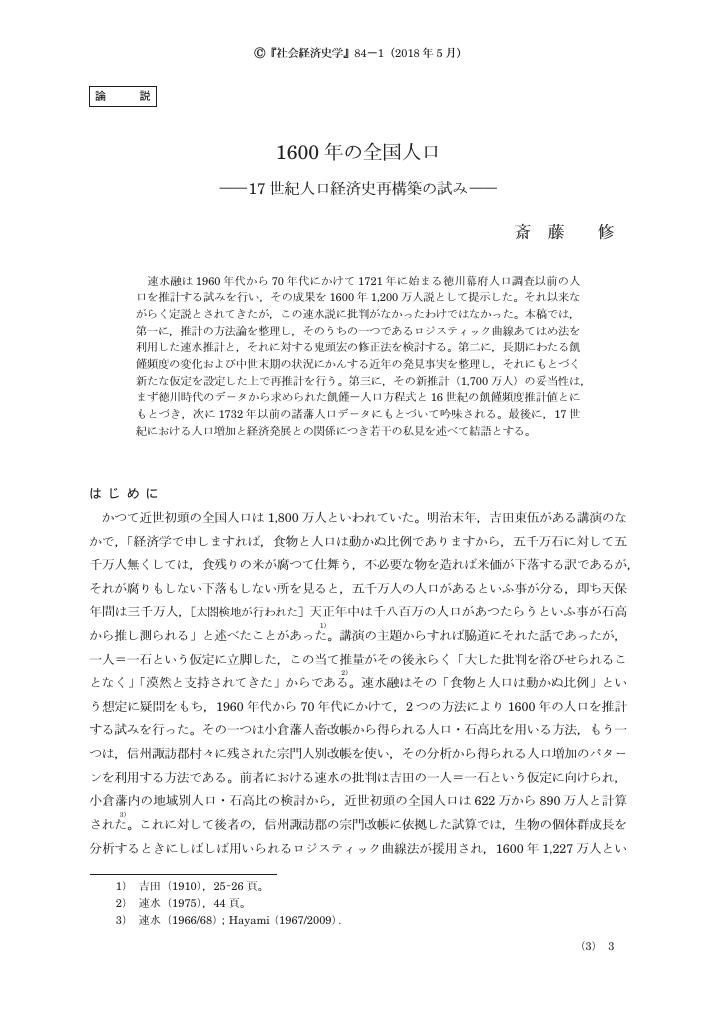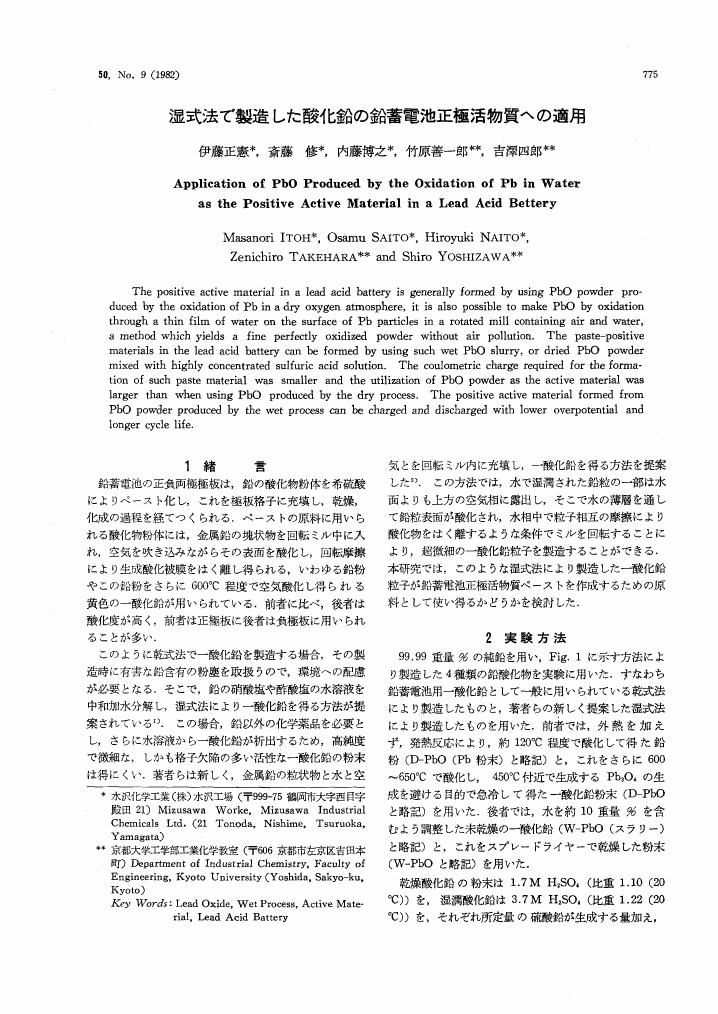14 0 0 0 OA 世界史における日本の近世:長期の視点からみた成長・格差・国家
- 著者
- 斎藤 修
- 出版者
- 日本学士院
- 雑誌
- 日本學士院紀要 (ISSN:03880036)
- 巻号頁・発行日
- vol.72, no.Special_Issue, pp.233-250, 2018-04-11 (Released:2018-05-23)
12 0 0 0 OA 透析患者の皮膚掻痒症に対する塩酸フェキソフェナジンの有効性の検討
- 著者
- 斎藤 修 草野 英二 戸澤 亮子 伊澤 佐世子 斎藤 孝子 武藤 重明 村山 直樹 目黒 輝雄 奥田 康輔 下山 博身 四宮 俊彦 金 成洙 廣瀬 悟 黒川 仁
- 出版者
- 一般社団法人 日本透析医学会
- 雑誌
- 日本透析医学会雑誌 (ISSN:13403451)
- 巻号頁・発行日
- vol.42, no.7, pp.507-514, 2009-06-28 (Released:2009-09-15)
- 参考文献数
- 24
血液透析患者における皮膚掻痒症は患者のQOL(quality of life)を低下させる合併症の一つであり,現在のところ主として抗ヒスタミン薬が皮膚掻痒症の治療に用いられている.今回,われわれは塩酸フェキソフェナジンを血液透析患者に投与し,透析患者の皮膚掻痒症に対する有効性を自覚症状に加えてQOLならびに睡眠の面からも併せて検討した.VAS(visual analogue scale)スコアで40以上の掻痒を訴える80例の維持血液透析患者が登録され,77例を解析対象とした.塩酸フェキソフェナジン60 mgを1日2回朝夕食後8週間経口投与し,自覚症状,QOL,睡眠障害ならびに日中の眠気の評価を2,4,8週間後に実施した.かゆみの自覚症状はVASを用いて評価し,QOLはSkindex 29を用いて評価した.塩酸フェキソフェナジンの投与開始2週間後には,かゆみの強さ,範囲,頻度のいずれも投与開始前に比して有意に改善軽快し(p<0.001),8週まで連続して有意な改善を認めた.また,Skindex 29のいずれのスコアも投与開始後には投与開始前に比して有意に低下し(p<0.001),QOLの改善がみられた.夜間の睡眠障害は塩酸フェキソフェナジンの投与により有意に改善され(p<0.001),その結果,日中の眠気も有意に改善された(p<0.001).また重篤な有害事象は認められなかった.以上の結果より塩酸フェキソフェナジンは2週間の投与でも掻痒症状・QOLおよび睡眠障害の有意な改善効果を認め,その効果は継続投与でさらに8週まで改善がみられた.塩酸フェキソフェナジンは安全性も高く,血液透析患者の皮膚掻痒症に有用であることが示唆された.
11 0 0 0 IR 武士と手代--徳川日本の「正社員」 (特集 正社員の自由時間の使い方)
- 著者
- 斎藤 修
- 出版者
- 労働政策研究・研修機構
- 雑誌
- 日本労働研究雑誌 (ISSN:09163808)
- 巻号頁・発行日
- vol.48, no.7, pp.60-66, 2006-07
6 0 0 0 OA 前近代日本の一人あたりGDP:推計・分析・国際比較
- 著者
- 斎藤 修 深尾 京司 攝津 斉彦 尾高 煌之助 尾関 学 ジャンーパスカル バッシーノ スティーブ ブロードベリ 高島 正憲 ジェラルト シュラース
- 出版者
- 一橋大学
- 雑誌
- 基盤研究(B)
- 巻号頁・発行日
- 2014-04-01
明治以前日本における一人当り国内総生産(GDP)統計を人口・都市化データの整備と新たな推計方法の考案によって改訂し、目的は達成した。1600年全国人口は問題点の一つであったが,速水融の1200万説に代わる新推計を完成させた。また,都市化についても新たな成果を得,これらに依拠したGDPの新推計と部門分割をとりまとめた。一人当りGDP値は,国際的な準拠データであったマディソン推計とは異なり,後半期の増加率がより高く推計された。他方,産出高の部門シェアからみる構造変化は,一人当りGDPが伸びなかった17世紀に大きく,安定成長の後半期には逆に構造変化がなかったという結果となった。
5 0 0 0 OA 1600年の全国人口 17世紀人口経済史再構築の試み
- 著者
- 斎藤 修
- 出版者
- 社会経済史学会
- 雑誌
- 社会経済史学 (ISSN:00380113)
- 巻号頁・発行日
- vol.84, no.1, pp.3-23, 2018 (Released:2020-05-26)
5 0 0 0 OA 江戸町人の結婚・出生行動分析 : 1860年代末の日本橋・神田の戸籍資料による
- 著者
- 斎藤 修 友部 謙一
- 出版者
- 日本人口学会
- 雑誌
- 人口学研究 (ISSN:03868311)
- 巻号頁・発行日
- vol.11, pp.59-62, 1988-05-30 (Released:2017-09-12)
3 0 0 0 分子及び分子錯体の反応と物性に関する共同研究及び研究動向調査
- 著者
- 井口 洋夫 MUNRO I.H. UNDERHILL A. PHILLIPS D. SARRE P.J. ROBB M.A. DAY P. 丸山 有成 宇理須 恒雄 吉原 經太郎 斎藤 修二 中村 宏樹 伊藤 光男 DAY Peter R J.Donovan J P.Simons 平谷 篤也 阿波賀 邦夫 川嶋 良章 十倉 好紀 馬場 正昭 宮島 清一 長嶋 雲兵 M H.Palmer 藤平 正道 入江 正浩 P B.Davies A Carrington B J.Howard J M.Brown R N.Dixon 吉野 勝美 川口 健太郎 遠藤 泰樹 小尾 欣一 高見 道生 廣田 榮治 福井 一俊 MUNRO I. MEECH S.R. STACE A.J. SIMONS J.P. DONOVAN R.J. 岡田 正 川崎 昌博 加藤 肇 西 信之
- 出版者
- 岡崎国立共同研究機構
- 雑誌
- 国際学術研究
- 巻号頁・発行日
- 1991
分子計算化学に関する5+5ミーティング、放射光利用化学に関する5+5ミーティング及び分子科学5分野合同のミーティングをそれぞれ、岡崎の分子科学研究所、英国ダ-ズベリ-研究所及び英国アビントンのSERC会議所において下記の通り開催した。学術研究上の情報交換・討議が大変有意義な中に実施され、将来計画についても忌憚のない意見交換が行われた。詳細は別途冊子にまとめられる。(1)分子計算化学5+5ミーティング平成5年7月15日-17日に分子科学研究所に於て日英5+5ミーティングが行れた。イギリス側の参加者はDr.B.Sutcliffe(Univ.York),Prof.M.Robb(Kings Colledge),Dr.H.Rzepa(Imperial Colledge),Dr.D.Wales(Cambridge Univ.)とProf.J.Connor(Univ of Manchester)の5名であり、日本側は中村宏樹、大峰巌(分子研)、平尾公彦(名大、東大)、岩田末廣(慶応)、加藤重樹(京大)、山下晃一(基礎化研)の6名であった。英国における計算分子科学の現状、非断熱遷移と多次元トンネル、光異性化反応、水素結合多様性、クラスターの光解離、クラスターの構造、光解離反応、量子波束動力学、溶液のダイナミックス、反応における共鳴現象等々広範囲に亘る有益な討論が行われた。最後に、共同研究実施の問題点、将来への改良点を検討した。若手研究者の交流を深める事、出来れば1996年英国で会合を開く事で合意した。(2)放射光利用化学5+5ミーティング平成5年10月21-22日英国ダ-ズベリ-研において同分野のミーティングを開催した。出席者は日本側から伊藤光男分子研所長、井口洋夫岡崎機構機構長、宇理須恒雄、小杉信博、鎌田雅夫、見附孝一朗、西尾光弘(分子研)及び岩田末廣(慶大)の8名、英国側はA.J.Leadbetterダ-ズベリ-研所長、Munro、West、Hasnain、Jones、Eastham(ダ-ズベリ-)、Comer(マンチェスター)及びWeightman(リバプール大)の8名であった。会議はダ-ズベリ-研の研究プログラムの紹介、分子研SORにおける日英交流の成果報告にはじまり、13件の学術報告がなされた。原子分子の高励起状態、タンパク質分子、固体電子状態、反応素過程、固体表面反応、電励起電子状態理論及び有機材料の光電子分光などについて有益な討議が行われた。最後に、原子分子、固体表面、光表面反応等に関する将来の共同研究の可能性及び1995年に次回ミーティングを開催する可能性について議論した。(3)5分野合同ミーティング平成5年10月17日-20日、英国アビントンのSERC会議所において、5分野合同のミーティングを開催し、学問的議論を行うと共に、今後の日英協力のあり方について討議を行った。学問的討議内容及びその他の詳細については別途に作成される冊子にまとめられる。将来計画等についての議論の概要は次の通りである。(1)英国側科学行政一般についての説明(2)日英協力事業の日本側での運用方法についての説明(3)他機関・財団等に関する情報交換(4)本事業の将来計画について今迄の本協力事業の実績をお互いに振り返り、将来計画を討議した。少ない予算の中でも、大変有意義に進められてきた事を確認しあった。特に、5+5ミーティングは両国間の研究活動情報の交換と共同研究育成の為に大変有益に作用している。今後は、若手研究者の相互長期滞在による共同研究の奨励を一層推進していくべきであるという点で合意した。これには上記(3)の活用が不可欠となろう。来年度以後の具体的計画についても話し合い、その大筋を認めあった。各分野のキーパーソン同志の連絡を一層緊密にする事とした。因みに、平成6年度には、高分解能分光のミーティングを英国で、電子構造のミーティングを日本で開催し、予算の許す範囲で日本人若手研究者を3〜4名派遣する事とした。
2 0 0 0 OA 湿式法で製造した酸化鉛の鉛蓄電池正極活物質への適用
- 著者
- 伊藤 正憲 斎藤 修 内藤 博之 竹原 善一郎 吉澤 四郎
- 出版者
- 公益社団法人 電気化学会
- 雑誌
- 電気化学および工業物理化学 (ISSN:03669297)
- 巻号頁・発行日
- vol.50, no.9, pp.775-781, 1982-09-05 (Released:2019-10-10)
2 0 0 0 OA 人口転換論を再考する
- 著者
- 斎藤 修
- 出版者
- 日本学士院
- 雑誌
- 日本學士院紀要 (ISSN:03880036)
- 巻号頁・発行日
- vol.73, no.1, pp.1, 2018 (Released:2018-10-11)
- 参考文献数
- 81
Mortality decline, the first phase of the demographic transition, has long been considered a transition triggered by the industrial revolution. This paper is an attempt to question this traditional view, putting forward a set of arguments, first, that the mortality transition was a longer process than conventionally thought, starting a century earlier than the onset of modern economic growth, and second, that a substantial increase in the level of life expectancy at birth, a summary measure of age-specific mortality rates, was indeed a prerequisite of modern economic growth and, hence, of fertility transition, the second phase of the demographic transition. The article begins with a brief overview of the historiography in demography, epidemiology and medical history. Much effort has been made to account for the historical process of mortality decline, and from the past debates there are a couple of lessons learned. One is that while medical progress can no longer explain the early decline in mortality, public health measures are likely to have played an important part. The other is that there is not much evidence to support the claim that economic development led to reductions in death rates. The demographer Samuel Preston demonstrated, by assembling country data on both life expectancy at birth and national income per capita for the 1930s and the 1960s, that the curve representing the relationship between the two factors (called the Preston curve) shifted significantly upwards between the two time-periods. According to his analysis of inter-temporal shifts, income growth per se explained only 16 per cent of the rise in longevity while a bundle of other factors accounted for 84 per cent; and the only variable that had a statistically significant correlation with the gain in life expectancy was the initial level of income – though, contrary to the expectation, its sign was negative. There are also suggestions by historians that in earlier stages where epidemics were more frequent nutrition is unlikely to have been a decisive factor to bring the level of mortality down. According to a recent synthesis in evolutionary biology of pathogens, there is a trade-off between their lethality and transmission potential. Diseases with high lethality, such as plague and smallpox, do not usually depend on their human host for transmission, whereas pathogens that are transmitted person to person but cannot persist outside the host are under strong selective pressure against high host lethality. Based on this conceptual framework as well as stylised facts from English historical demography, Romola Davenport of the Cambridge Group for the History of Population and Social Structure argues that infectious diseases reduced or eliminated in periods before 1870 are those of the first type, while childhood infections and other diseases that lingered on into the first half of the twentieth century are of the second type. Indeed, the Cambridge Group’s path-breaking work on the historical demography of England, c.1540-1870, reveals that from the late seventeenth century onwards adult, child and neonatal mortality rates started to decline but the post-neonatal mortality rate did not. Over the long run, in other words, deaths from pestilence and famine were reduced, thanks to early modern economic growth or the implementation of rudimentary measures in public health by government authorities, or both, while exposure to infection was on the rise, suggesting that the long-term decline of mortality started well before the industrial revolution, but the process became prolonged as industrialisation and urbanisation progressed. (View PDF for the rest of the abstract.)
2 0 0 0 IR 書評論文 勤勉革命論の実証的再検討〔速水融著『近世日本の経済社会』〕
- 著者
- 斎藤 修
- 出版者
- 慶應義塾経済学会
- 雑誌
- 三田学会雑誌 (ISSN:00266760)
- 巻号頁・発行日
- vol.97, no.1, pp.151-161, 2004-04
2 0 0 0 ピーター・ラスレットとケンブリッジ・グループ(学界消息)
- 著者
- 斎藤 修
- 出版者
- 日本人口学会
- 雑誌
- 人口学研究 (ISSN:03868311)
- 巻号頁・発行日
- vol.30, pp.71-75, 2002
2 0 0 0 OA 戦前期第三次産業所得の再推計―『長期経済統計』改訂の試み―
連携研究者とともに近代日本の府県別産業別GDPを推計した。本研究の特徴は、既存の推計がカバーしていない1874年のデータを新たに構築した点にある。新しいデータセットを使った分析によって明らかになった主要な事実は以下の通りである。①従来考えられているよりも明治初期の日本は豊かであり、②明治期の経済成長率は低かった(それはすなわち、江戸時代の経済成長率が高かったことを意味する)、③地域間格差は明治初期に大きく拡大し、その後格差の拡大に歯止めがかかるが、このような変化の背後には人口の地域間移動が大きく影響していたと考えられる。
2 0 0 0 OA DNAにおける塩基対開裂状態のソリトン理論
- 著者
- 斎藤 修 畠中 憲之 佐久間 哲郎
- 出版者
- 北海道大学 = Hokkaido University
- 雑誌
- 北海道大學工學部研究報告 (ISSN:0385602X)
- 巻号頁・発行日
- vol.130, pp.43-54, 1986-03-25
1 0 0 0 OA 学校宿直制度の実態とその検討(第一報) : 廃止直前の頃
- 著者
- 八藤後 忠夫 斎藤 修平 青木 純一 岡本 紋弥 佐藤 和平
- 出版者
- 文教大学
- 雑誌
- 生活科学研究 = Bulletin of Living Science (ISSN:02852454)
- 巻号頁・発行日
- vol.38, pp.189-194, 2016-03-30
聞き書きによる学校宿直廃止直前時の情況把握の結果,以下のことが推察された.1)この時期は,地域がそれ以前以上に学校・教師に接近し,その一体化が行われた.2)学校の地域からの信頼感は残存しており,それゆえ教師間の繋がりも公的・私的に混在し相補的な関係を継続していた.3)その傾向がこの時期の宿直という時空間に投影されている.
1 0 0 0 OA 英国産業革命論の現在
- 著者
- 斎藤 修
- 出版者
- 日本学士院
- 雑誌
- 日本學士院紀要 (ISSN:03880036)
- 巻号頁・発行日
- vol.76, no.2, pp.203-234, 2022 (Released:2022-02-15)
- 参考文献数
- 57
The historical interpretation of the British industrial revolution has undergone a significant change since the 1960s. The publication of British Economic Growth, 1688-1959 by P. Deane and W. A. Cole in 1962 marked an epoch by applying national accounting methods to eighteenth- and nineteenth-century historical data. Their stage-specific estimates of real gross domestic product (GDP) growth were thought to reflect the acceleration process of industrial and GDP growth in the c.1760-1830 period, during which a series of innovations are said to have revolutionised the scene of manufacturing. However, this interpretation was radically revised by Nick Crafts' 1985 book, British Economic Growth during the Industrial Revolution. With his estimates of slower rates of GDP growth and arguments derived from growth accounting analysis, it is suggested that the contribution of new technologies (such as steam engine) to output growth was surprisingly low, taking more time in harvesting the fruit of a general-purpose technology (GPT) than we tended to assume. The thesis of slow growth was reconfirmed by a 1992 joint-paper by Crafts and Knick Harley and the growth accounting scenario by Crafts' own 2018 book. (View PDF for the rest of the abstract.)
1 0 0 0 プロト工業化の時代 : 西欧と日本の比較史
- 著者
- 斎藤 修 高島 正憲
- 出版者
- 岩波書店
- 雑誌
- 経済研究 (ISSN:00229733)
- 巻号頁・発行日
- vol.71, no.2, pp.129-143, 2020-04
1 0 0 0 OA 分光学の基礎 第3講分子の回転・振動スペクトル
- 著者
- 広田 栄治 斎藤 修二
- 出版者
- 社団法人 日本分光学会
- 雑誌
- 分光研究 (ISSN:00387002)
- 巻号頁・発行日
- vol.33, no.3, pp.199-214, 1984-06-30 (Released:2010-06-28)
- 参考文献数
- 29
1 0 0 0 OA 土地貸借市場としての地主小作関係 友部仮説の検討
- 著者
- 斎藤 修
- 出版者
- 大阪経済大学日本経済史研究所
- 雑誌
- 経済史研究 (ISSN:1344803X)
- 巻号頁・発行日
- vol.12, pp.250-272, 2009-02-10 (Released:2018-11-01)
1 0 0 0 OA ソーシャル・サイエンス・ヒストリィ事始―個人的な回想―
- 著者
- 斎藤 修
- 出版者
- 東洋大学人間科学総合研究所
- 雑誌
- 東洋大学人間科学総合研究所紀要 = The Bulletin of the Institute of Human Sciences,Toyo University (ISSN:13492276)
- 巻号頁・発行日
- vol.22号別冊, pp.25-32, 2019-10





